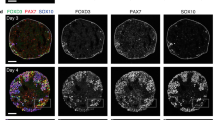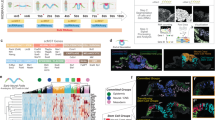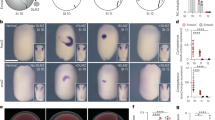Abstract
The neural crest is a stem population critical for development of the vertebrate craniofacial skeleton and peripheral ganglia. Neural crest cells originate along the border between the neural plate and epidermis1, migrate extensively and generate numerous derivatives, including neurons and glia of the peripheral nervous system, melanocytes, bone and cartilage of the head skeleton2. Impaired neural crest development is associated with human defects, including cleft palate3. Classically, the neural crest has been thought to form by interactions at the border between neural and non-neural ectoderm or mesoderm4,5,6,7, and defined factors such as bone morphogenetic proteins (BMPs) and Wnt proteins have been postulated as neural crest-inducers8,9,10,11,12,13. Although competence to induce crest cells declines after stage 10 (ref. 14), little is known about when neural crest induction begins in vivo. Here we report that neural crest induction is underway during gastrulation and well before proper neural plate appearance. We show that a restricted region of chick epiblast (stage 3–4) is specified to generate neural crest cells when explanted under non-inducing conditions. This region expresses the transcription factor Pax7 by stage 4 + and later contributes to neural folds and migrating neural crest. In chicken embryos, Pax7 is required for neural crest formation in vivo, because blocking its translation inhibits expression of the neural crest markers Slug, Sox9, Sox10 and HNK-1. Our results indicate that neural crest specification initiates earlier than previously assumed, independently of mesodermal and neural tissues, and that Pax7 has a crucial function during neural crest development.
This is a preview of subscription content, access via your institution
Access options
Subscribe to this journal
Receive 51 print issues and online access
$199.00 per year
only $3.90 per issue
Buy this article
- Purchase on Springer Link
- Instant access to full article PDF
Prices may be subject to local taxes which are calculated during checkout



Similar content being viewed by others
References
His, W. Untersuchungen über die erste Anlage des Wirbeltierleibes. Die erste Entwicklung des Hühnchens im Ei (Vogel, Leipzig, 1868)
Le Douarin, N. & Kalcheim, C. The Neural Crest (Cambridge Univ. Press, Cambridge, 1999)
Wilkie, A. O. & Morriss-Kay, G. M. Genetics of craniofacial development and malformation. Nature Rev. Genet. 2, 458–468 (2001)
Basch, M. L., Garcia-Castro, M. I. & Bronner-Fraser, M. Molecular mechanisms of neural crest induction. Birth Defects Res. C Embryo Today 72, 109–123 (2004)
Moury, J. D. & Jacobson, A. G. Neural fold formation at newly created boundaries between neural plate and epidermis in the axolotl. Dev. Biol. 133, 44–57 (1989)
Selleck, M. A. & Bronner-Fraser, M. Origins of the avian neural crest: the role of neural plate-epidermal interactions. Development 121, 525–538 (1995)
Dickinson, M. E., Selleck, M. A., McMahon, A. P. & Bronner-Fraser, M. Dorsalization of the neural tube by the non-neural ectoderm. Development 121, 2099–2106 (1995)
Basler, K., Edlund, T., Jessell, T. & Yamada, T. Control of cell pattern in the neural tube: regulation of cell differentiation by dorsalin-1, a novel TGFβ family member. Cell 73, 687–702 (1993)
Liem, K. F. Jr, Tremml, G., Roelink, H. & Jessell, T. M. Dorsal differentiation of neural plate cells induced by BMP-mediated signals from epidermal ectoderm. Cell 82, 969–979 (1995)
García-Castro, M. I., Marcelle, C. & Bronner-Fraser, M. Ectodermal Wnt function as a neural crest inducer. Science 297, 848–851 (2002)
Saint-Jeannet, J. P., He, X., Varmus, H. E. & Dawid, I. B. Regulation of dorsal fate in the neuraxis by Wnt-1 and Wnt-3a. Proc. Natl Acad. Sci. USA 94, 13713–13718 (1997)
LaBonne, C. & Bronner-Fraser, M. Neural crest induction in Xenopus: Evidence for a two-signal model. Development 125, 2403–2414 (1998)
Mayor, R., Guerrero, N. & Martinez, C. Role of FGF and noggin in neural crest induction. Dev. Biol. 189, 1–12 (1997)
Basch, M. L., Selleck, M. A. & Bronner-Fraser, M. Timing and competence of neural crest formation. Dev. Neurosci. 22, 217–227 (2000)
Chi, N. & Epstein, J. A. Getting your Pax straight: Pax proteins in development and disease. Trends Genet. 18, 41–47 (2002)
Nieto, M. A., Sargent, M. G., Wilkinson, D. G. & Cooke, J. Control of cell behaviour during vertebrate development by Slug, a zinc finger gene. Science 264, 835–839 (1994)
Cheung, M. & Briscoe, J. Neural crest development is regulated by the transcription factor Sox9. Development 130, 5881–5893 (2003)
Streit, A. et al. Chordin regulates primitive streak development and the stability of induced neural cells, but is not sufficient for neural induction in the chick embryo. Development 125, 507–519 (1998)
Streit, A. & Stern, C. D. Establishment and maintenance of the border of the neural plate in the chick: involvement of FGF and BMP activity. Mech. Dev. 82, 51–66 (1999)
Pera, E., Stein, S. & Kessel, M. Ectodermal patterning in the avian embryo: epidermis versus neural plate. Development 126, 63–73 (1999)
Bang, A. G., Papalopulu, N., Kintner, C. & Goulding, M. D. Expression of Pax-3 is initiated in the early neural plate by posteriorizing signals produced by the organizer and by posterior non-axial mesoderm. Development 124, 2075–2085 (1997)
Garcia-Martinez, V., Alvarez, I. S. & Schoenwolf, G. C. Locations of the ectodermal and nonectodermal subdivisions of the epiblast at stages 3 and 4 of avian gastrulation and neurulation. J. Exp. Zool. 267, 431–446 (1993)
Fernàndez-Garre, P., Rodríguez-Gallardo, L., Gallego-Díaz, V., Alvarez, I. S. & Puelles, L. Fate map of the chicken neural plate at stage 4. Development 129, 2807–2822 (2002)
Goulding, M. D., Chalepakis, G., Deutsch, U., Erselius, J. R. & Gruss, P. Pax-3, a novel murine DNA binding protein expressed during early neurogenesis. EMBO J. 10, 1135–1147 (1991)
Mansouri, A., Stoykova, A., Torres, M. & Gruss, P. Dysgenesis of cephalic neural crest derivatives in Pax7-/- mutant mice. Development 122, 831–838 (1996)
Mansouri, A. The role of Pax3 and Pax7 in development and cancer. Crit. Rev. Oncog. 9, 141–149 (1998)
Mansouri, A. & Gruss, P. Pax3 and Pax7 are expressed in commissural neurons and restrict ventral neuronal identity in the spinal cord. Mech. Dev. 78, 171–178 (1998)
Monsoro-Burq, A. H., Wang, E. & Harland, R. Msx1 and Pax3 cooperate to mediate FGF8 and WNT signals during Xenopus neural crest induction. Dev. Cell 8, 167–178 (2005)
McLarren, K. W., Litsiou, A. & Streit, A. DLX5 positions the neural crest and preplacode region at the border of the neural plate. Dev. Biol. 259, 34–47 (2003)
Sheng, G., dos Reis, M. & Stern, C. D. Churchill, a zinc finger transcriptional activator, regulates the transition between gastrulation and neurulation. Cell 115, 603–613 (2003)
Acknowledgements
We thank A. Streit, S. Fraser, A. Groves, L. Gammill, V. Lee, J. Sechrist and T. Moreno for comments and discussions; S. Mackem, D. Wilkinson, E. Matsunaga, A. Kawakami, O. Pourquié and H. Kondoh for gifts of Tbx6l, cMsx1, full-length cPax3, full-length cPax7, BMP4, Sox2, Dlx5 and Gata2 probes and constructs; and D. Arce and Y. Liu for technical assistance. This work was supported by a USPHS grant to M.B.-F.
Author information
Authors and Affiliations
Corresponding author
Ethics declarations
Competing interests
Reprints and permissions information is available at npg.nature.com/reprintsandpermissions. The authors declare no competing financial interests.
Supplementary information
Supplementary Figures
This file contains Supplementary Figures 1 and 2 and Supplementary Table 1. (DOC 1844 kb)
Supplementary Methods
This file contains additional details of the methods used in this study. (DOC 23 kb)
Rights and permissions
About this article
Cite this article
Basch, M., Bronner-Fraser, M. & García-Castro, M. Specification of the neural crest occurs during gastrulation and requires Pax7. Nature 441, 218–222 (2006). https://doi.org/10.1038/nature04684
Received:
Accepted:
Issue Date:
DOI: https://doi.org/10.1038/nature04684
Comments
By submitting a comment you agree to abide by our Terms and Community Guidelines. If you find something abusive or that does not comply with our terms or guidelines please flag it as inappropriate.



